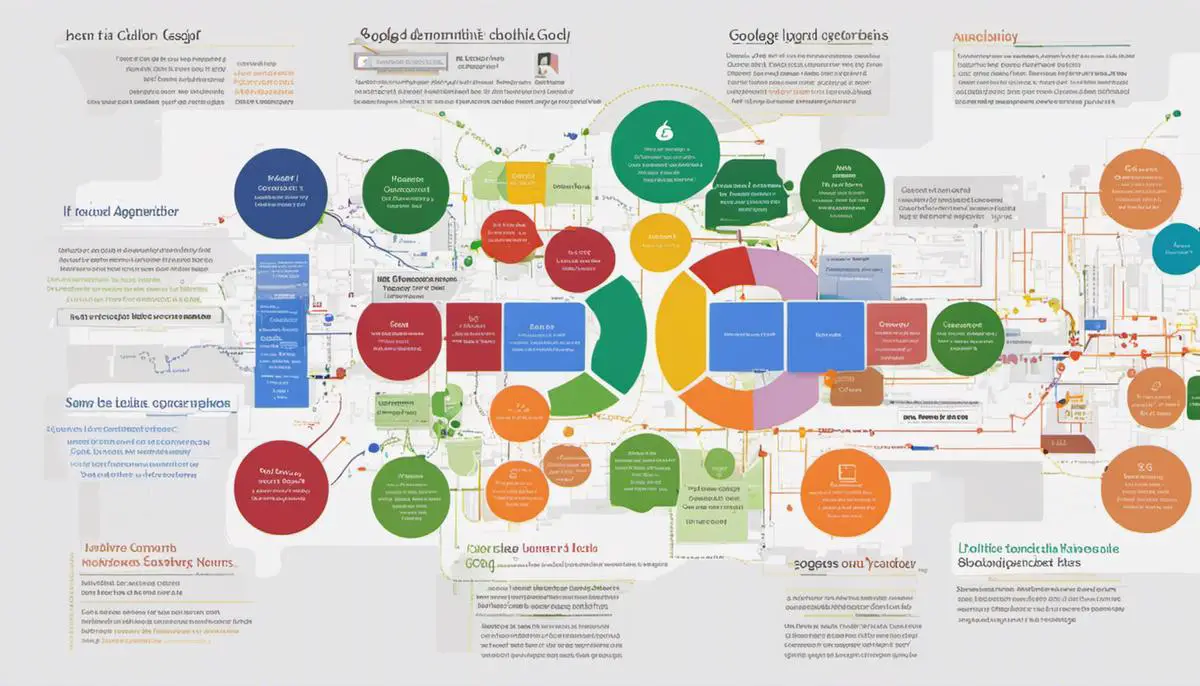Why is Google Scholar so popular among researchers nowadays? How did it come into being? How does it work and how relevant has it become to the world of research? This article answers all these questions.
Google Scholar, a freely accessible web search engine, stands as a cornerstone in the realm of academic research today. Its journey from nascent curiosity to an essential tool for researchers worldwide is a story full of innovation, technology, robust algorithms, and versatile features.
Scholars across the globe now navigate through their research endeavors backed by the power of this user-friendly and richly facilitated platform.
This in-depth examination will probe the evolution of Google Scholar, its intricate operational mechanisms, the utility of the various features and tools it offers to its users, and the impressive impact and influence it had, and continues to have, on research world.
Table of Contents
The Evolution of Google Scholar
The Evolution of Google Scholar: Meeting the Changing Research Needs of Academia
Google Scholar, a free and widely accessible scholarly literature database, was first introduced to the academic sphere in 2004. Initially met with widespread skepticism, it has since experienced numerous alterations to address the complex, evolving needs of academia.
This analysis aims to elucidate the various stages of development that Google Scholar has undergone, focusing particularly on its adaptation to advancing research necessities.
The inception of Google Scholar offered a new dimension to scholarly research, providing users access to a vast array of academic literature encompassing books, conference papers, theses, dissertations, and more. Its search algorithm, reminiscent of Google’s ubiquitously employed PageRank, fostered a nexus between related academic resources, thus breaking the shackles of subject isolation.
However, Google Scholar’s infancy was marred by criticism, primarily regarding its lack of transparency and certain indexing processes. Responding to these concerns, in 2006, Google Scholar allowed linking to library resources, enabling seamless access to subscription-based sources. This integration amplified the depth of available literature and significantly enriched the user experience.
From 2009 to 2012, Google Scholar underwent tangible advancements with features like “My Library” and “My Citations.” These additions offered personalized literature collection and easy citation tracking, acknowledging the growing need for customizable and user-centric services in academia.
Subsequent features such as Scholar Library in 2013 and Scholar Alerts in 2014 further contributed to the enrichment of Google Scholar. The former permitted users to save articles directly in their personal library, thus facilitating accessibility. The latter, Scholar Alerts, served to keep researchers abreast of recent publications in their field, underscoring the platform’s commitment to ongoing scholarly communication.
One of the most critical developments in Google Scholar was the inclusion of citation metrics in 2011. The introduction of the h-index, i10-index, and five-year impact factor granted users a comprehensive view of article impact and author productivity, directly responding to academia’s pressing need for measuring publication impact and scholarly influence.
Google Scholar’s evolution continued with the introduction of a case law database in 2009 for legal research, leading to the broadening of the spectrum of services provided. The platform also made strides towards improving the accessibility by introducing a mobile version of Google Scholar in 2012, recognizing the shift towards mobile-oriented research in academia.
Google Scholar’s adaptability and unyielding commitment to continuous improvement have positioned it as a vital tool within academia. From initial skepticism due to transparency issues to being lauded for expansive access to academic resources, Google Scholar’s evolution has been substantial.
The future of Google Scholar rests on its ability to keep pace with the dynamic needs of an ever-evolving academic ecosystem. As academic research becomes increasingly interdisciplinary, collaborative, and global, Google Scholar’s challenge lies in expanding its functionality and inclusivity, thereby strengthening its role in the academic discourse. This journey from its inception to its current form abundantly demonstrates that Google Scholar’s evolution has been, and continues to be, as multifaceted and enlightening as the academic research it serves.

Mechanisms of Google Scholar
The defining factor behind the functionality of Google Scholar lies primarily in the underlying algorithms and the criteria defining relevancy and ranking of the retrieved academic resources. These elements serve as the foundation for Google Scholar’s ability to sift through an immense range of sources and accurately deliver the most relevant scholarly documents to researchers globally.
Google Scholar employs a fundamentally different approach compared to traditional scholarly databases. While they often utilize manual curation or discipline-specific indexing to curate database entries, Google Scholar’s algorithmic approach constructs an expansive corpus of scholarly documents, from articles in high-impact, peer-reviewed journals to theses and dissertations, conference papers, preprints, and technical reports. Its automated nature allows for more dynamic and comprehensive indexing, although it also opens up ethical considerations around the control and quality of information.
Relevancy in Google Scholar primarily pertains to the algorithm’s sophistication in data cross-referencing. The tool employs an iterative process to navigate through layers of information that link scholarly documents together. It goes beyond merely matching searched keywords with document titles, looking instead at the number and quality of citations each document has received. In this regard, Google Scholar mimics the way academics measure a publication’s influence, acknowledging that heavily cited documents often carry greater informational weight.
This brings us to another defining characteristic of Google Scholar: ranking. Google Scholar’s algorithms deploy a hierarchical sorting scheme which places significant weight on the number of citations when determining rank. Publications with higher citation counts generally take precedence over less-cited work. This approach approximates academic peer review, with citations serving as community validation.
Another crucial factor is the recency of a publication. Google Scholar acknowledges the temporal aspect of academic research by often prioritizing newer items over older ones, maintaining relevancy to current scholarship. It is also important to acknowledge that the ranking process is also influenced by a document’s full text availability, the author’s reputation, the journal’s reputation, and the diversity of citing documents.
The role of authorship and journal-related information in the ranking process has been a subject of intense scrutiny. Some scholars express concern over the emphasis on well-established and prolific authors and high-ranking journals, potentially sidelining less-known authors and smaller journals. These concerns bring to the fore issues of bias and equality in Google Scholar’s approach.
Google Scholar’s complex algorithms and dynamic ranking system present both opportunities and challenges within an increasingly digital academic ecosystem. These frameworks, with their multifaceted understanding of relevancy and influence, seek to mirror the complex realities of scholarly research by allowing a diverse array of documents to come to the surface.
However, long-standing issues of bias and access remain significant, indicating the continuous need for interrogation and adjustment as this tool evolves within the changing landscape of academic research.

Google Scholar Features and Tools
The scientific community may be intrigued to delve into the underpinning algorithms that enable Google Scholar to function as it does today. This search engine, premised on the task of comprehensively identifying and compiling scholarly documents, owes its formation to ground-breaking algorithms that simultaneously scan billions of pages on the internet.
In a departure from traditional scholarly databases, Google Scholar offers a uniquely expansive corpus of scholarly documents. While conventional databases curate their indexed articles from selected academic journals, Google Scholar’s search domain incorporates articles from not just journals, but theses, pre-prints, conference proceedings, scholarly books and more. Such a unique and broad search scope is crucial in fueling comprehensive research.
Google Scholar’s search domain incorporates articles from not just journals, but theses, pre-prints, conference proceedings, scholarly books and more.
Critical to Google Scholar’s functionality is its approach to deciphering relevancy in search results – a facet achieved through its intuitive algorithm. The algorithm surveys an extensive amount of data but transcends mere keyword matching, instead placing a focus on semantic understanding to discern relevance.
Another characteristic feature of Google Scholar is the hierarchical sorting scheme, underpinned by a robust ranking process. Results of any search inquiry are never random. Instead, they descend from the most authoritative and comprehensive sources, a reflection of the algorithm’s prioritization.
The sorting relies heavily on aspects like recency, full text availability, the reputation of the author, journal reputation, and even the frequency of citation. This aggregate information helps assemble an almost hierarchical schema of search results, bringing pertinent and scholarly superior sources to the foreground.
Despite a plethora of advantages, Google Scholar also faces a steady stream of concerns and criticisms. Prominent among them is the issue of bias. Critics argue that the erstwhile ‘democratization of information’ inclines more towards established authors and journals, primarily those in English.
Equality, thus, is another intense critique. Researchers from developing countries and less prevalent languages often find themselves at the bottom of search results. A predominantly English-speaking, western viewpoint exists in the Scholar’s rankings, which could limit the breadth and diversity of a researcher’s discovery process.
Just like any other complex system, Google Scholar’s algorithms and ranking system come with both opportunities and challenges. While it offers an impressive scope of research materials, the potential skewed representation and concerns about openness are issues the scholarly community needs to address.
An ongoing, rigorous interrogation and periodic adjustments of Google Scholar are warranted. As it evolves within the churning ocean of academic research, these tweaks and improvements may ensure it better and equitably serves the research community worldwide.
In conclusion, an appreciation of underlying algorithms, ranking processes, and the overwhelming scale of Google Scholar is integral for its adept use. A cognizance of its opportunities and challenges can stimulate informed discussions among researchers, librarians, and educators on how to best leverage this powerful tool in the ever-evolving academic landscape.
Impact and Influence of Google Scholar
Having covered important features of Google Scholar, it is necessary to delve into an often-overlooked aspect of its capabilities: linguistic inclusivity. The coverage of Google Scholar spans over multiple languages, helping to bridge the gap between academia across various regions of the world. This multilingual feature of Google Scholar allows scholars to access research in languages other than their own, catalyzing the cross-pollination of ideas globally.
Regarding functionality, Google Scholar employs a one-box model for data input, as opposed to the complex queries required by traditional databases. This streamlined approach fosters an intuitive and user-friendly experience, particularly for novice researchers. The shift towards a singular search box echoes broader trends in online information retrieval practices.
Google Scholar’s ease of use is further manifested in its direct-links-to-PDF-functionality, where possible. This feature remains an integral part of the user experience, lowering barriers to access and engaging researchers more readily in the academic discourses they are interested in.
Among the innovations brought about by Google Scholar is the large-scale indexing of theses and dissertations, a feature uncharted by many traditional databases. This, along with the inclusion of conference papers, patents, and other grey literature, augments the research landscape by providing a platform for early-career researchers to disseminate their work.
Despite the transformative power and convenience brought about by Google Scholar, it is not void of challenges. There are concerns about the erosion of source literacy due to the prevalence of the one-box search model. This may encourage an uncritical acceptance of search results without regard for the authority, relevance, and credibility of sources – a skill drilled into seasoned researchers through traditional databases.
Additionally, the coverage of Google Scholar, although vast, is not exhaustive. Not all scholarly publications are visible, leading to concerns of ‘academic invisibility’ if one’s research is not indexed. This draws attention to the importance of balancing the use of Google Scholar with traditional databases.
The opaque nature of Google Scholar’s search algorithm leads to lack of clarity about how results are curated. This veiled mechanism brings forth questions about power dynamics and control over knowledge in the academic space which need serious consideration.
In essence, Google Scholar has undeniably revolutionized academic research, making it more accessible and inclusive by incorporating features and improvements geared towards user-centricity. As the research landscape continues to evolve, Google Scholar remains a critical component, providing researchers with an extensive corpus of scholarly documents at their fingertips.
However, the platform’s power in shaping scholarly visibility and discourse also ignites questions about bias, equality, and transparency, stimulating ongoing discourse on the place and role of such platforms in the future of academic research.
Pioneering an era of ease, efficiency, and inclusivity in research, Google Scholar’s role is undeniably transformative. Each update, each new feature it introduces, serves to drive knowledge growth and accessibility.
However, as we continue to witness an explosive development in technology, it becomes even more crucial to ponder upon the future directions that Google Scholar may take. Embracing the platform remains key to staying at the forefront of academic research, a testament to the profound influence of this tool in shaping the journey of researchers and information seekers worldwide.


